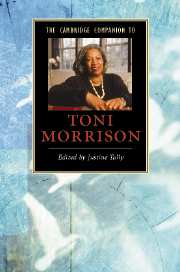Book contents
- Frontmatter
- Introduction: “All necks are on the line”
- Part I Toni Morrison’s fiction
- 1 The Bluest Eye and Sula: black female experience from childhood to womanhood
- 2 Song of Solomon and Tar Baby: the subversive role of language and the carnivalesque
- 3 Beloved or the shifting shapes of memory
- 4 Jazz and Paradise: pivotal moments in black history
- 5 The Morrison trilogy
- 6 Love and the survival of the black community
- 7 The artistic impulse of Toni Morrison’s shorter works
- Part II Toni Morrison’s criticism and editing
- Part III Essays
- Part IV Further Reading
- Index
5 - The Morrison trilogy
from Part I - Toni Morrison’s fiction
Published online by Cambridge University Press: 28 January 2008
- Frontmatter
- Introduction: “All necks are on the line”
- Part I Toni Morrison’s fiction
- 1 The Bluest Eye and Sula: black female experience from childhood to womanhood
- 2 Song of Solomon and Tar Baby: the subversive role of language and the carnivalesque
- 3 Beloved or the shifting shapes of memory
- 4 Jazz and Paradise: pivotal moments in black history
- 5 The Morrison trilogy
- 6 Love and the survival of the black community
- 7 The artistic impulse of Toni Morrison’s shorter works
- Part II Toni Morrison’s criticism and editing
- Part III Essays
- Part IV Further Reading
- Index
Summary
Though critical evaluation of Morrison's novels Beloved (1987), Jazz (1992), and Paradise (1998) has been copious (in descending order, respectively), there has been a curious critical silence concerning what the author herself has described as a trilogy. In spite of the author's indication that her editors imposed the break-up of her original project for Beloved, insisting that it was too long, certain critics have argued that the relationship among the resulting works is tenuous and that most readers are interested only in each individual novel - again in descending order. This fact notwithstanding, there are many valid reasons for considering these three novels as a whole artistic endeavor. This essay intends to invigorate the discussion and point to ways in which critical inquiry might be expanded.
The most obvious and superficial links among the three novels concern the relationship between the temporal and spatial locus of each, what Mikhail Bakhtin would call the chronotope. Beloved is set during the 1870s in the rural area outside of Cincinnati, Ohio, with flashbacks to plantations in Kentucky and (probably) Carolina, and a chain gang in Alfred, Georgia, during slavery. The emphasis on the rural is exchanged for the urban beat of “the City” in the 1920s in Jazz, while the flashbacks are centered on the Reconstruction Era of the 1870s. Paradise moves the locus forward to the 1970s to a small-town setting in Ruby, but the memories that constantly surface concern the “Founding Fathers” of Haven in the 1870s after the political failure of Reconstruction, and the second migration during the 1920s to the “perfect” all-black town of Ruby in Oklahoma. The time frame thus set out spans one hundred years of black life in the United States, and the interrelated settings encompass black experience in the rural South, the urban North and the small-town (southern) Mid-West.
- Type
- Chapter
- Information
- The Cambridge Companion to Toni Morrison , pp. 75 - 91Publisher: Cambridge University PressPrint publication year: 2007
- 5
- Cited by

